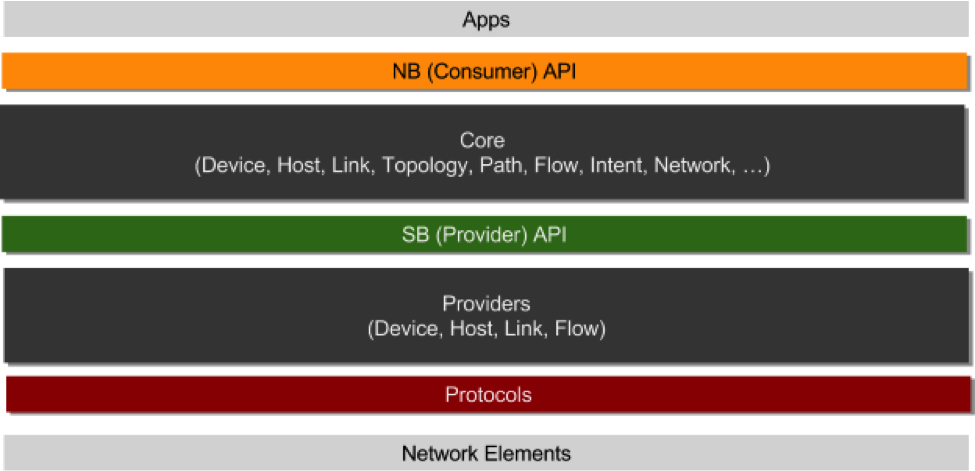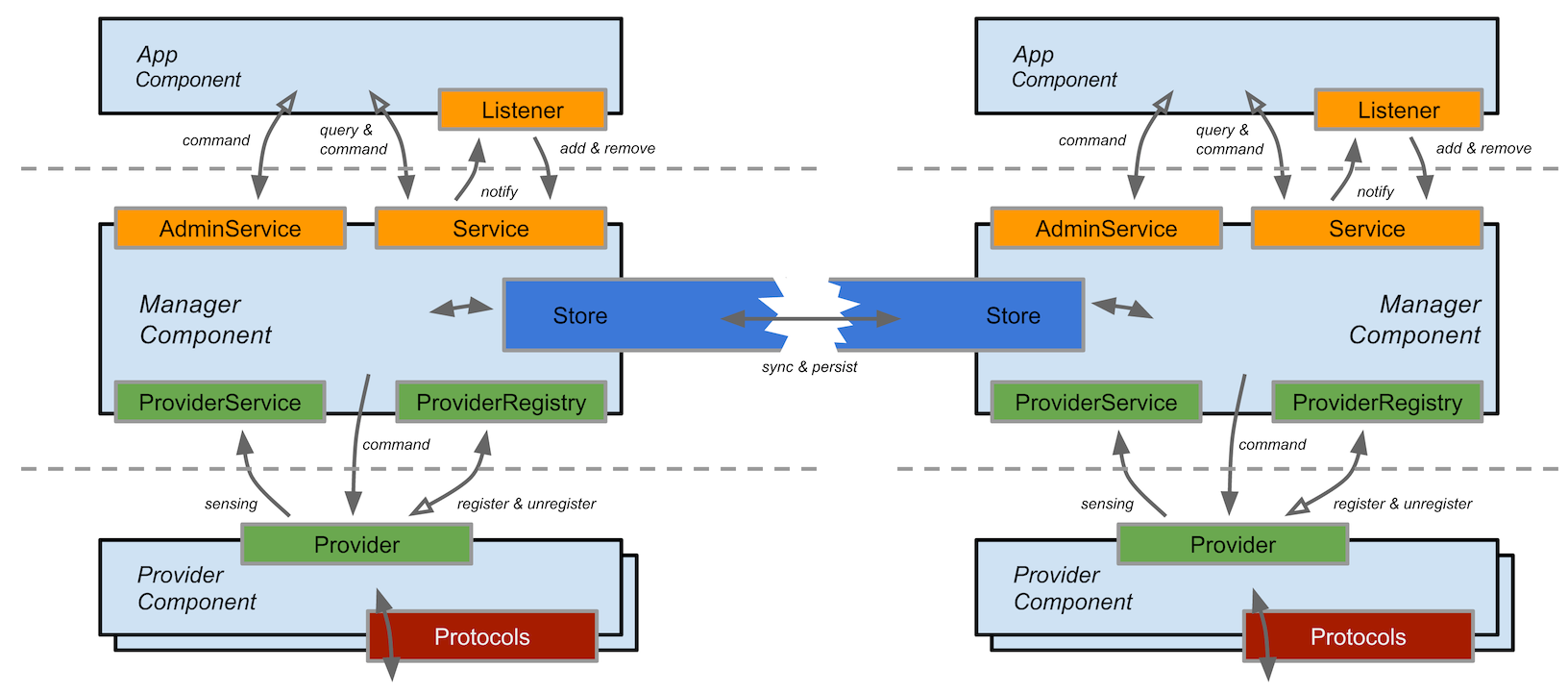This section describes the organization of the major subsystems found in ONOS.
System Tiers
As mentioned in the previous section, ONOS is architected with tiers of functionality. We present the following figure as a summary of the discussions in the next few sections :
Services and Subsystems
A service is a unit of functionality that is comprised of multiple components that create a vertical slice through the tiers as a software stack. We refer to the collection of components making up the service as a subsystem. We use the terms 'service' and 'subsystem' interchangeably in this guide.
ONOS defines several primary services:
- Device Subsystem - Manages the inventory of infrastructure devices.
- Link Subsystem - Manages the inventory of infrastructure links.
- Host Subsystem - Manages the inventory of end-station hosts and their locations on the network.
- Topology Subsystem - Manages time-ordered snapshots of network graph views.
- PathService - Computes/finds paths between infrastructure devices or between end-station hosts using the most recent topology graph snapshot.
- FlowRule Subsystem - Manages inventory of the match/action flow rules installed on infrastructure devices and provides flow metrics.
- Packet Subsystem - Allows applications to listen for data packets received from network devices and to emit data packets out onto the network via one or more network devices.
Network representation
As their names suggest, each subsystem acts upon a specific aspect of the network. ONOS maintains both protocol-specific and protocol-agnostic representations of various network elements and properties, albeit in different tiers (Provider and Core, respectively).
Additionally, some elements are built from other elements. These derivative elements may not have a protocol-specific representation. One example is the Topology, built from Devices and Links.
Subsystem Structure
Each of a subsystem's components resides in one of the three main tiers, and can be identified by one or more Java Interfaces that they implement.
The figure below summarizes the relationships of the subsystem components. The top and bottom dotted lines in the figure represent the inter-tier boundaries created by the northbound and southbound APIs, respectively.
Provider
The lowest tier of the ONOS stack, Providers interface with the network via protocol-specific libraries, and with the core via the ProviderService interface.
The protocol-aware providers are responsible for interacting with the network environment using various control and configuration protocols, and supplying service-specific sensory data to the core. Providers may also collect data from other subsystems, converting them into service-specific data.
Some providers may also need to accept control edicts from the core and apply them to the network using the appropriate protocol-specific means. These are fed into the Provider via the ProviderService interface.
Provider ID
A Provider is associated with a ProviderId. The main purpose of the ProviderId is to provide an externalizable identity of a family of providers, which allows devices and other model entities to remain associated with the identity of the provider responsible for their existence even after the provider is uninstalled/unloaded.
The ProviderId carries a URI scheme designation to allow for loosely pairing devices with providers from an alternate provider family, and for this to be possible without access to the Provider itself.
Manager
A component residing in the core, the Manager receives information from Providers and serves it to applications and other services. It exposes several interfaces :
- A northbound Service interface through which applications or other core components can learn about a particular aspect of the network state
- An
AdminServiceinterface for taking administrative commands and applying them onto the network state or the system - A southbound
ProviderRegistryinterface through which Providers can register with the manager, so that it may interact with it - A southbound
ProviderServiceinterface presented to a registered Provider, through which it may send and receive information to and from the manager
The consumers of a Manager's service interface may receive information both synchronously by querying the service, and asynchronously as an event listener (e.g. by implementing an EventListener interface).
Store
Also within the core and associated closely with the Manager, Stores have the task of indexing, persisting and synchronizing the information received by the Manager. This includes ensuring consistency and robustness of information across multiple ONOS instances by directly communicating with stores on other ONOS instances through the StoreDelegate interface.
Application
Applications consume and manipulate information aggregated by the managers via the AdminService and Service interfaces. Applications have a wide range of functionality, ranging from displaying network topologies in a web browser to setting up paths for network traffic.
Application ID
Each application is associated with a unique ApplicationId. This identifier is used by ONOS to track context associated with an application (e.g. tasks and objectives such as intents and flow rules). To obtain a valid ID, applications register with the CoreService, providing their name which is expected to follow the reverse DNS notation, e.g. org.onlab.onos.fwd.
Not all subsystems possess all of these components, and not all components strictly adhere to these functions. For example, TopologyProvider purely acts upon the system core's protocol-agnostic representations of devices and links, and never interacts with the infrastructure directly, and CoreService is implemented by CoreManager, a Manager that implements only a Service interface.
Events and Descriptions
Two fundamental units of information distribution within ONOS are Events and Descriptions. As with services, Events and Descriptions are associated with specific network elements and concepts. Both are immutable once created.
Descriptions
Descriptions are used to pass information about a element across the southbound API. For example, a HostDescription contains information about a host's MAC and IP Addresses and its location in the network (VLAN ID and device/port attachment point).
Events
A Description is transcribed into an Event once it enters the system core. Events are used by Managers to notify its listeners about changes in the network, and by Stores to notify their peers of events that should be known globally. For example, a DeviceEvent can be used to notify DeviceListeners that a device has been detected (DEVICE_ADDED), lost (DEVICE_REMOVED), or some aspect of it has changed (DEVICE_UPDATED), among others.
Events are generated by the Store, and dispatched by the Manager via the EventDeliveryService.

